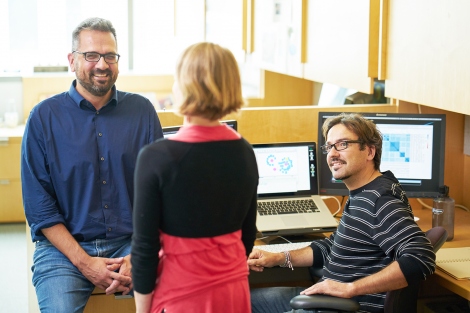
Researchers believe mapping the connections between genes and proteins in many human cell types could hold the answers to understanding diseases from tuberculosis to cancer to autism. Illustration by Nevan Krogan Lab/QBI
Nevan Krogan, PhD, is a mapmaker, but the object of his exploration is not any newfound continent or alien world. Instead, he and his colleagues map cells. Rather than cities, towns and interstates, these maps show proteins, genes, and the shifting, convoluted network of interactions between them.
Learning to read these maps, Krogan believes, is key to the future of precision treatments for diseases from tuberculosis to Tourette disorder.
“At the cellular level, I see no distinction between being infected with HIV and having cancer. It’s just a set of proteins that are behaving badly to put the cell in a disease state,” said Krogan, who is director of the Quantitative Biosciences Institute (QBI) and a professor of cellular and molecular pharmacology at UC San Francisco and a senior investigator in the academically affiliated Gladstone Institutes.

Krogan’s insight is that nearly all diseases are fundamentally mechanical problems at the level of our genes and the microscopic protein machines they produce and regulate. The challenge is that the vast number of genes and proteins in human cells can influence one another in complex, hard-to predict ways.
Currently, researchers tend to study the genes and proteins responsible for disease in isolation, but they are missing the big picture, Krogan believes.
Armed with complete maps of how genes and proteins interact in human cells, researchers could finally see how dozens of seemingly unrelated genes and proteins involved in a disease are in fact all part the same interconnected biological pathway. What’s more, increasing evidence suggests that the same defective biological pathways may be involved in disorders as different as autism and cancer.
Based on this unifying framework for understanding human disease, researchers at QBI, under Krogan’s leadership, along with colleagues at UC San Diego and UC Berkeley, have founded three ambitious map-making initiatives that aim to reshape three major pillars of human medicine: infectious disease, cancer and psychiatric disorders.